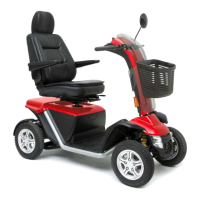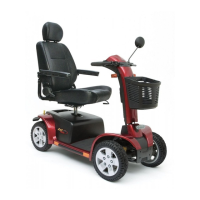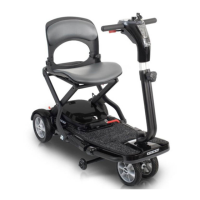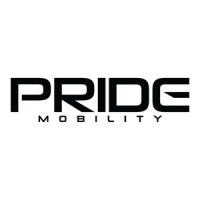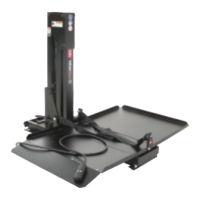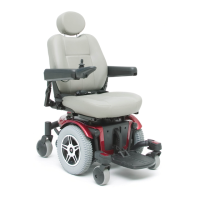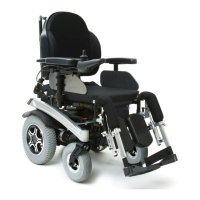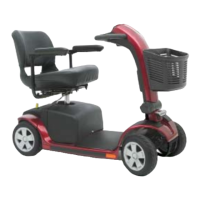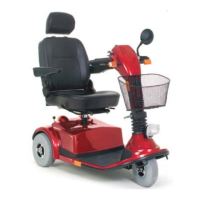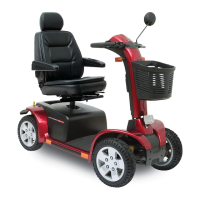Do you have a question about the Pride Mobility PURSUIT and is the answer not in the manual?
Importance of reading and following manual instructions for safe operation and service.
User's promise not to modify the product or remove safety features.
Instructions for checking delivery completeness and reporting damage.
How to contact Pride Mobility for questions, comments, and updates.
Explanation of symbols used on the scooter and in the manual for warnings.
Mandatory actions for safe operation, including reading the manual.
Warning against modifying the scooter or using unauthorized accessories.
Warning against lifting the scooter by its removable parts.
Recommendation to perform a safety check before each use.
Guidance on maintaining correct tire pressure for safety and operation.
Information on maximum weight capacity and consequences of exceeding it.
Precautions for operating the scooter on inclines and declines.
Factors affecting tipping during cornering and how to prevent it.
Explanation of the scooter's regenerative and disc park brake systems.
Guidance on suitable and unsuitable outdoor driving surfaces.
Warnings and instructions for navigating obstacles like curbs and steps.
Precautions for operating the scooter in adverse weather conditions.
Explanation of freewheel mode operation and safety warnings.
Prohibition of using stairs/escalators and safe door operation.
Safety tips for using elevators and lift systems with the scooter.
Mandatory actions and warnings for battery handling, disposal, and recycling.
Warning to turn off power when in a stationary position for extended periods.
Recommendations for securing the scooter during motor vehicle transport.
Safety tips for safely mounting and dismounting the scooter.
Warnings about reaching/bending and their effect on stability.
Importance of positioning belts and consulting physicians for limitations.
Warnings about operating under the influence of alcohol, drugs, and smoking.
Information about EMI/RFI and its potential effects on the scooter.
Overview of controls and functions on the tiller console, including speed, horn, signals, lights, and throttle.
Instructions for powering the scooter on/off and reading battery charge.
Information about the scooter's electrical system fuses and their purpose.
Identification of components like batteries, anti-tip wheels, and freewheel lever in the rear.
Function and reset procedure for the main circuit breaker.
Instructions for properly securing the scooter for motor vehicle transport.
Overview of battery requirements and the charging system.
How to interpret the battery condition meter.
Safety precautions and instructions for charging the scooter batteries.
Answers to common questions about battery charging.
Guidelines on determining charging frequency based on usage.
Tips for maximizing scooter battery lifespan and performance.
Suggestions for optimizing scooter range on a single charge.
Recommendations for suitable battery types and sizes.
Step-by-step instructions for replacing scooter batteries.
Pre-operation checks and step-by-step guide for safely mounting the scooter.
Essential pre-ride adjustments and safety checks for operation.
Detailed instructions on how to operate the scooter, including controls.
Step-by-step guide for safely getting off the scooter and powering down.
Explanation of the automatic power down feature and how to resume operation.
Instructions for adjusting the tiller's angle for comfort.
Guidance on installing and adjusting mirrors for better visibility.
How to adjust the seatback angle for comfortable riding.
How to adjust the seat's rotation and front-to-back position.
Instructions for adjusting the seat height.
Step-by-step guide on how to disassemble the scooter into components.
Instructions on how to separate and reassemble the front and rear sections.
Explanation of diagnostic flash codes for troubleshooting.
Troubleshooting steps for a completely unresponsive scooter.
Troubleshooting steps for when the scooter fails to move.
Troubleshooting steps for a repeatedly tripping main circuit breaker.
Troubleshooting steps for battery issues affecting motor performance.
Importance of maintaining tire pressure and conducting wheel checks.
Instructions for cleaning and maintaining the scooter's exterior surfaces and plastic parts.
Checks for battery terminals, wiring harnesses, and electronic components.
Information on axle bearings, motor transaxle, and motor brushes.
Steps for replacing fuses and guidelines for nylon lock nuts.
Guidelines for storing the scooter for extended periods.
Information on proper scooter disposal according to regulations.
Identifies the specific model number and general compliance standards.
Details on maximum incline, obstacle climbing, speed, range, and ground clearance.
Specifications for length, width, weight, turning radius, and tires.
Information on seating, drive system, braking, batteries, and charger.
Importance of reading and following manual instructions for safe operation and service.
User's promise not to modify the product or remove safety features.
Instructions for checking delivery completeness and reporting damage.
How to contact Pride Mobility for questions, comments, and updates.
Explanation of symbols used on the scooter and in the manual for warnings.
Mandatory actions for safe operation, including reading the manual.
Warning against modifying the scooter or using unauthorized accessories.
Warning against lifting the scooter by its removable parts.
Recommendation to perform a safety check before each use.
Guidance on maintaining correct tire pressure for safety and operation.
Information on maximum weight capacity and consequences of exceeding it.
Precautions for operating the scooter on inclines and declines.
Factors affecting tipping during cornering and how to prevent it.
Explanation of the scooter's regenerative and disc park brake systems.
Guidance on suitable and unsuitable outdoor driving surfaces.
Warnings and instructions for navigating obstacles like curbs and steps.
Precautions for operating the scooter in adverse weather conditions.
Explanation of freewheel mode operation and safety warnings.
Prohibition of using stairs/escalators and safe door operation.
Safety tips for using elevators and lift systems with the scooter.
Mandatory actions and warnings for battery handling, disposal, and recycling.
Warning to turn off power when in a stationary position for extended periods.
Recommendations for securing the scooter during motor vehicle transport.
Safety tips for safely mounting and dismounting the scooter.
Warnings about reaching/bending and their effect on stability.
Importance of positioning belts and consulting physicians for limitations.
Warnings about operating under the influence of alcohol, drugs, and smoking.
Information about EMI/RFI and its potential effects on the scooter.
Overview of controls and functions on the tiller console, including speed, horn, signals, lights, and throttle.
Instructions for powering the scooter on/off and reading battery charge.
Information about the scooter's electrical system fuses and their purpose.
Identification of components like batteries, anti-tip wheels, and freewheel lever in the rear.
Function and reset procedure for the main circuit breaker.
Instructions for properly securing the scooter for motor vehicle transport.
Overview of battery requirements and the charging system.
How to interpret the battery condition meter.
Safety precautions and instructions for charging the scooter batteries.
Answers to common questions about battery charging.
Guidelines on determining charging frequency based on usage.
Tips for maximizing scooter battery lifespan and performance.
Suggestions for optimizing scooter range on a single charge.
Recommendations for suitable battery types and sizes.
Step-by-step instructions for replacing scooter batteries.
Pre-operation checks and step-by-step guide for safely mounting the scooter.
Essential pre-ride adjustments and safety checks for operation.
Detailed instructions on how to operate the scooter, including controls.
Step-by-step guide for safely getting off the scooter and powering down.
Explanation of the automatic power down feature and how to resume operation.
Instructions for adjusting the tiller's angle for comfort.
Guidance on installing and adjusting mirrors for better visibility.
How to adjust the seatback angle for comfortable riding.
How to adjust the seat's rotation and front-to-back position.
Instructions for adjusting the seat height.
Step-by-step guide on how to disassemble the scooter into components.
Instructions on how to separate and reassemble the front and rear sections.
Explanation of diagnostic flash codes for troubleshooting.
Troubleshooting steps for a completely unresponsive scooter.
Troubleshooting steps for when the scooter fails to move.
Troubleshooting steps for a repeatedly tripping main circuit breaker.
Troubleshooting steps for battery issues affecting motor performance.
Importance of maintaining tire pressure and conducting wheel checks.
Instructions for cleaning and maintaining the scooter's exterior surfaces and plastic parts.
Checks for battery terminals, wiring harnesses, and electronic components.
Information on axle bearings, motor transaxle, and motor brushes.
Steps for replacing fuses and guidelines for nylon lock nuts.
Guidelines for storing the scooter for extended periods.
Information on proper scooter disposal according to regulations.
Identifies the specific model number and general compliance standards.
Details on maximum incline, obstacle climbing, speed, range, and ground clearance.
Specifications for length, width, weight, turning radius, and tires.
Information on seating, drive system, braking, batteries, and charger.
| Brand | Pride Mobility |
|---|---|
| Model | PURSUIT |
| Category | Mobility Aid |
| Language | English |
